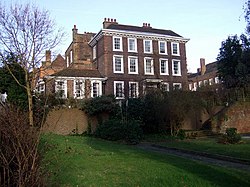
Joseph Rudyard Kipling was an English novelist, short-story writer, poet, and journalist. He was born in British India, which inspired much of his work.
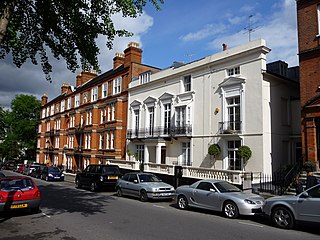
Hampstead is an area in London, England, which lies four miles northwest of Charing Cross, and extends from the A5 road to Hampstead Heath, a large, hilly expanse of parkland. The area forms the northwest part of the London Borough of Camden, a borough in Inner London which for the purposes of the London Plan is designated as part of Central London.

Wimpole Estate is a large estate containing Wimpole Hall, a country house located within the civil parish of Wimpole, Cambridgeshire, England, about 8+1⁄2 miles southwest of Cambridge. The house, begun in 1640, and its 3,000 acres (12 km2) of parkland and farmland are owned by the National Trust. The estate is regularly open to the public and received over 335,000 visitors in 2019. Wimpole is the largest house in Cambridgeshire.

Witanhurst is a large Grade II* listed 1930s Georgian Revival mansion on 5 acres (2.0 ha) in Highgate, North London. It has had several prominent owners since being rebuilt by soap magnate Sir Arthur Crosfield. After several decades of increasing dilapidation, it underwent substantial refurbishment after its 2008 sale to an offshore company owned by the family of Russian businessman Andrey Guryev.

Bateman's is a 17th-century house located in Burwash, East Sussex, England. It was the home of Rudyard Kipling from 1902 until his death in 1936. The house was built in 1634. Kipling's widow Caroline bequeathed the house to the National Trust on her death in 1939. The house is a Grade I listed building.

Burwash, archaically known as Burghersh, is a rural village and civil parish in the Rother district of East Sussex, England. Situated in the High Weald of Sussex some 15 miles (24 km) inland from the port of Hastings, it is located five miles (8 km) south-west of Hurst Green, on the A265 road, and on the River Dudwell, a tributary of the River Rother. In an area steeped in history, some nine miles (14 km) to the south-east lies Battle Abbey and eight miles (13 km) to the east is Bodiam Castle.
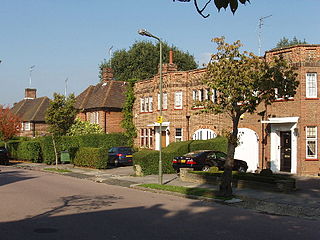
Hampstead Garden Suburb is an elevated suburb of London, north of Hampstead, west of Highgate and east of Golders Green. It is known for its intellectual, liberal, artistic, musical and literary associations. It is an example of early twentieth-century domestic architecture and town planning in the London Borough of Barnet, northwest London.

Kenwood House is a former stately home in Hampstead, London, on the northern boundary of Hampstead Heath. The house was originally constructed in the 17th century and served as a residence for the Earls of Mansfield during the 18th and 19th centuries.
The Landmark Trust is a British building conservation charity, founded in 1965 by Sir John and Lady Smith, that rescues buildings of historic interest or architectural merit and then makes them available for holiday rental. The Trust's headquarters is at Shottesbrooke in Berkshire.
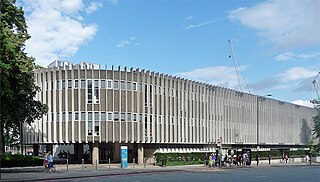
Swiss Cottage Library is a public library in the London Borough of Camden housed in an architectural landmark building on Avenue Road. Designed by Sir Basil Spence of Spence, Bonnington & Collins, it was built between 1963 and 1964.

The World's End is a pub and music venue at 174 Camden High Street in Camden Town, London, England, just south of Camden Town tube station with an additional branch at Finsbury Park, 23 Stroud Green Rd, London. It is a long established business, formerly known as Mother Red Cap or Mother Damnable's.

Avenue House is a large Victorian mansion situated on East End Road in Finchley in the London Borough of Barnet.
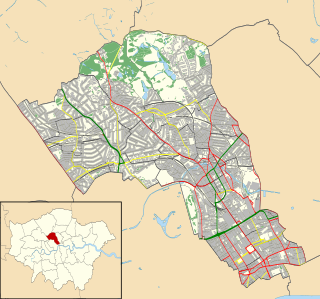
The London Borough of Camden is in percentage terms the second-greenest of the Inner London boroughs. It contains most of the swathe of land Hampstead Heath and many smaller green spaces. The Central London part of the borough, south of Euston Road, is characterised by its elegant garden squares with large instances: Tavistock Square and Bedford Square. In this part runs the Regent's Canal around the top edge of Regent's Park, a little of which is in Camden, including all of associated Primrose Hill. Highgate Cemetery is in Camden but Highgate Wood is in the neighbouring borough of Haringey.

Naulakha, also known as the Rudyard Kipling House, is a historic Shingle Style house on Kipling Road in Dummerston, Vermont, a few miles outside Brattleboro. The house was designated a National Historic Landmark in 1993 for its association with the author Rudyard Kipling (1865–1936), who had it built in 1893 and made it his home until 1896. It is in this house that Kipling wrote Captains Courageous, The Jungle Book, The Day's Work, and The Seven Seas, and did work on Kim and The Just So Stories. Kipling named the house after the Naulakha Pavilion, situated inside Lahore Fort in present-day Pakistan. The house is now owned by the Landmark Trust, and is available for rent.
George Louis St Clair Bambridge was a British diplomat. His wife, Elsie, was the daughter of the author Rudyard Kipling.
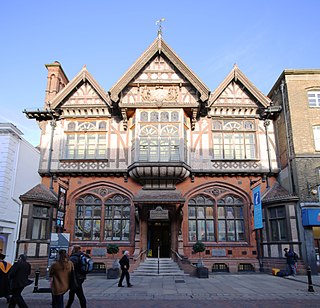
The Beaney House of Art and Knowledge is the central museum, library and art gallery of the city of Canterbury, Kent, England. It is housed in a Grade II listed building. Until it closed for refurbishment in 2009, it was known as the Beaney Institute or the Royal Museum and Art Gallery. It reopened under its new name in September 2012. The building, museum and art gallery are owned and managed by Canterbury City Council; Kent County Council is the library authority. These authorities work in partnership with stakeholders and funders.

The London Borough of Camden is a London borough in Inner London, England. Camden Town Hall, on Euston Road, lies 1.4 mi (2.3 km) north of Charing Cross. The borough was established on 1 April 1965 and includes the former Central London borough of Holborn, and St Pancras and Hampstead.

Buxton Crescent is a Grade-I-listed building in the town of Buxton, Derbyshire, England. It owes much to the Royal Crescent in Bath, but has been described by the Royal Institution of British Architects as "more richly decorated and altogether more complex". It was designed by the architect John Carr of York, and built for the 5th Duke of Devonshire between 1780 and 1789. In 2020, following a multi-year restoration and redevelopment project supported by the National Heritage Memorial Fund and Derbyshire County Council, The Crescent was reopened as a 5-star spa hotel.

Hampstead Town is a ward in the London Borough of Camden, in the United Kingdom. It covers most of Hampstead Village, the western half of Hampstead Heath, North End and the Vale of Health. The more residential Frognal ward covers much of the rest of Hampstead.
Malvina Cheek, A.R.C.A., was a British artist, best known for her work during World War II for the Recording Britain project. During the War she was commissioned for Recording Britain to make architectural records of old buildings in anticipation of their possible destruction. Eighteen finished works were presented to the scheme and her legacy is also preserved in many books.
